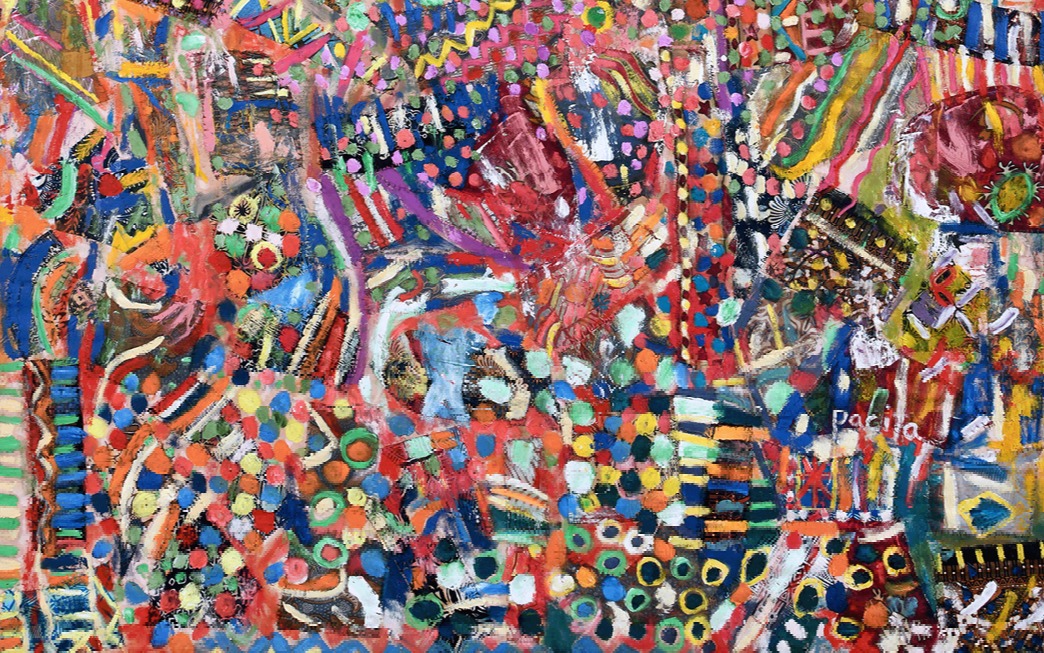
Pacita Abad
Pacita Abad
Curated By Victoria Sung and Matthew Villar Miranda
Walker Art Center
About
The exuberant and wide-ranging works of Pacita Abad (US, b. Philippines, 1946–2004) are the subject of the first-ever retrospective spanning the artist’s 32-year career. Abad is best known for her trapuntos, a form of quilted painting made by stitching and stuffing her canvases as opposed to stretching them over a wood frame. During her lifetime, the prolific artist made a vast number of artworks that traverse a diversity of subjects, from colorful masks to intricately constructed underwater scenes to abstract compositions. The exhibition includes more than 100 works—most of which have never been on public view in the United States—showcasing her experiments in different mediums, including textiles, works on paper, costumes, and ceramics. Organized by the Walker in collaboration with Abad’s estate, the presentation celebrates the multifaceted work of an artist whose vibrant visual, material, and conceptual concerns are as urgent today as they were three decades ago.
Abad moved to the United States in 1970 to escape political persecution after leading a student demonstration against the authoritarian Marcos regime. Informed by this experience, she was determined to give visibility to political refugees and oppressed peoples through her art: “I have always believed that an artist has a special obligation to remind society of its social responsibility.” Works from her Immigrant Experience series (1983–1995) highlight the rising multiculturalism of the 1990s. These works call attention to the era’s contradictions and omissions, centering the sufferings and triumphs of people on the periphery of power. The multiplicity of stories referenced in the series include such events as the 1992 Los Angeles riots, the Haitian refugee crisis, and the detention of Mexican migrant workers at the US border, offering an intimate look at lives often obscured by the reductive, xenophobic headlines of the time.
Though she became a US citizen in 1994, Abad lived for several years in a number of countries around the world, including Bangladesh, the Dominican Republic, Indonesia, Kenya, the Philippines, Singapore, and Sudan. Largely self-taught, she interacted with the various artistic communities she encountered on her travels, incorporating a diversity of cultural traditions and techniques—from Korean ink brush painting to Indonesian batik—into her expansive practice. Abad’s global, peripatetic existence is reflected in the portability of her works and in her use of textiles, a medium often associated with female, non-Western labor and historically marginalized as craft.
Presented in conjunction with Pacita Abad, the documentary Wild at Art (1995) offers an intimate portrait of the artist in Washington, DC, sharing stories of her life and work with filmmaker Kavery Kaul, including her Immigrant Experience series and the installation of Masks from Six Continents at the Metro Center subway station. Recently restored by the Academy Film Archive in 2023, the film was directed by Kavery Kaul, produced by Riverfilms, and presented by Asian Women United.
The exhibition is accompanied by the first major publication on Abad’s work, produced by the Walker. In addition to the most comprehensive documentation of the artist’s work to date, the volume includes texts by Victoria Sung, Julia Bryan-Wilson, Nancy Lim, Ruba Katrib, Xiaoyu Weng, and Matthew Villar Miranda as well as oral histories conducted with artists, curators, family members, and others who knew Abad, edited by Pio Abad and Victoria Sung.
Pacita Abad (b. 1946, Batanes, Philippines; d. 2004, Singapore) was the daughter of a congressman, who had hoped that she would traverse a similar political path. But the course of Abad’s life changed after a year of travelling in 1973 to Iran, Afghanistan, Pakistan, India, Sri Lanka, Myanmar, Thailand, Laos, Taiwan, and Hong Kong. She decided to take up painting. Abad later married a developmental economist, Jack Garrity, whose work predisposed them to travel to developing countries. Her experiences in each place informed her subject matter from the beginning; traditional art practices like ink-brush painting in Korea, paint brushing on silk in the Dominican Republic, batik painting in Indonesia, tie-dye in Africa, macramé in Papua New Guinea, were techniques she introduced either singly or several in one art work. In the late seventies and early eighties Abad introduced a quilting method, trapunto, onto her canvasses, which were then layered with objects on top of her quilted material: stones, sequins, glass, buttons, shells, mirrors, printed textile. She referred to this technique, and the process of layering, stuffing, stitching and the collaging of objects on painted canvas, as trapunto painting.
Characterised by vibrant colour and accumulated material, these large scale trapunto paintings traverse a diversity of subject matter: from tribal masks and social realist tableaus depicting the individuals and communities that Abad encountered throughout her travels, to lush and intricately constructed underwater compositions and abstractions. She lived and travelled in a bewildering amount of countries – from Bangladesh to Sudan, Sudan to Jakarta, Jakarta to Boston, Washington D.C. to Manila—and it is this itineracy that has defined and shaped her subject matter. Pacita Abad’s work brought together images and experiences across cultures, economies and histories and offered reflections on the global long before the discourses of globalisation and transnationalism were felt in the art world.
Her work has been featured in solo exhibitions at the National Museum, Jakarta, Indonesia; Hong Kong Arts Centre, Hong Kong, The Museum of Philippine Art, Manila; Cultural Center of the Philippines, Manila; Bhirasri Museum of Modern Art, Bangkok, Thailand; Singapore Tyler Print Institute, Singapore; The National Museum for Women in the Arts, Washington, D.C.; and the National Center of Afro-American Artists, Boston, among others. She has participated in numerous group exhibitions, including: Beyond the Border: Art by Recent Immigrant, Bronx Museum of the Arts, New York; Asia/America: Identities in Contemporary Asian American Art, a traveling exhibition organized by the Asia Society, New York; Olympiad of Art, National Museum of Modern Art, Seoul, Korea; 2nd Asian Art Show, Fukuoka Art Museum, Fukuoka, Japan and La Bienal de Habana, Havana, Cuba. She died in Singapore in 2004.
